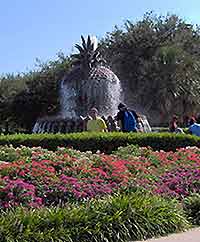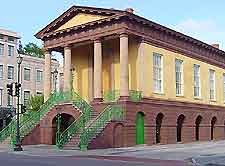Charleston History Facts and Timeline
(Charleston, South Carolina - SC, USA)

Known to many as the 'Holy City' due to its abundance of churches, Charleston is the second-biggest city in South Carolina. Charleston has a long history dating back to the 1600s, when it was known as Charles Towne. In the year of 1680, Charles Towne moved location to Oyster Point, but it wasn't until 1783 that it adopted its current name.
In its early days, the city was a North American colossus and featured in the top-five largest US cities. Nowadays, it ranks amongst the state's most important cities and features a well-mannered and hospitable local populace.
The Colonial Period
The original town was one of the southernmost English settlements, meaning that other Europeans regularly attacked Charles Towne from all directions. However, at this time during Charleston history, the city saw the beginnings of mass immigration, with Protestant groups such as the Germans and the French eventually welcomed.
The early economy was based on the deerskin trade, while affluent plantation owners employed African slaves to farm tea and rice. Visitors can learn more about this period by checking out the Charleston Museum on Meeting Street, which first opened in 1773, prior to the American Revolution.
The American Revolution
Charleston was the site of a key rearguard defense during the American Revolution era. On 28th June 1776, the British military attempted to take Charleston by force and rally support among its loyal followers in Carolina. While the city's unfinished fort was actually strong enough to weather the attack and dissuade British Loyalists from canvassing support, the British returned with larger forces in 1780 and overwhelmed the city. The first siege is still recognized to this day on 'Carolina Day', a state holiday marking the decisive victory of the Patriots on 28th June.
Exchange and Provost
The Old Exchange and Provost Dungeon building was constructed in 1767 and was the site of some of the post-American Revolution period's most significant events. In 1788, the US Constitution was ratified here, while 1791 saw the building host a number of events for George Washington. The Daughters of the American Revolution organization now manages the building as a museum, providing guided tours of the building in full-costume.
Growth and the American Civil War
During the post-American Revolution period, Charleston still relied on agriculture to drive its economy, continuing to employ slave labor. Racial tensions increased as the treatment of black folk deteriorated. After Charleston seceded from the Union in 1860, the city attracted the continued attention of the Union's forces over the next five years. The first shots of the American Civil War are said to have been fired in Charleston Harbor, at the Battle of Fort Sumter in 1861. Fort Sumter remains one of the principal historical attractions to this day. The city managed to avoid Union occupation for much of the war, but was eventually taken in 1865.

1886 Earthquake
The American Civil War caused untold damage to the city, but it was one of the biggest natural disasters in the history of Charleston that caused the most damage. On 31st August 1886, Charleston saw an earthquake measuring 7.5 on the Richter scale, which very nearly destroyed the whole city. At least 2,000 buildings were damaged and losses of around US$6,000,000 were reported.
Modern History
After the 1886 Earthquake, the city remained in the doldrums for a long time, and it wasn't until the second half of the 20th century that it saw any kind of renaissance. The city played a part in the 1960s Civil Rights Movement and this period saw the arrival of the 1969 Charleston Hospital Strike, a 100-day strike by black hospital workers. In 1989, another natural disaster came in the form of Hurricane Hugo.
The Charleston Historical District took the brunt of the storm, with more than 75 percent of homes reporting some kind of damage. However, the Historical District remains at the forefront of the city's tourist sector today, hosting historical attractions such as the Cathedral of St. Luke and St. Paul.
 Known to many as the 'Holy City' due to its abundance of churches, Charleston is the second-biggest city in South Carolina. Charleston has a long history dating back to the 1600s, when it was known as Charles Towne. In the year of 1680, Charles Towne moved location to Oyster Point, but it wasn't until 1783 that it adopted its current name.
Known to many as the 'Holy City' due to its abundance of churches, Charleston is the second-biggest city in South Carolina. Charleston has a long history dating back to the 1600s, when it was known as Charles Towne. In the year of 1680, Charles Towne moved location to Oyster Point, but it wasn't until 1783 that it adopted its current name.